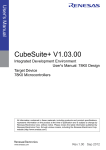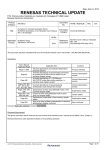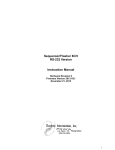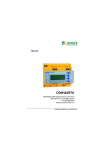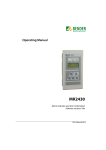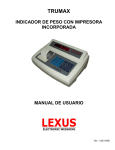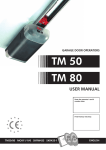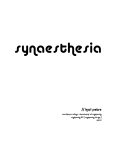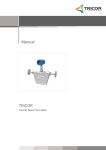Download 78K0S/Kx1+ Sample Program (8-bit Timer 80) Interval Timer AN
Transcript
Application Note
78K0S/Kx1+
Sample Program (8-bit Timer 80)
Interval Timer
This document describes an operation overview of the sample program and how to use it, as well as how to set and use
the interval timer function of 8-bit timer 80. In the sample program, the LEDs are blinked at fixed cycles by using the
interval timer function of 8-bit timer 80. Furthermore, the blinking cycle of the LEDs is changed in accordance with the
number of switch inputs.
Target devices
78K0S/KA1+ microcontroller
78K0S/KB1+ microcontroller
Document No. U18864EJ2V0AN00 (2nd edition)
Date Published September 2008 NS
2007
Printed in Japan
CONTENTS
CHAPTER 1 OVERVIEW ...................................................................................3
1.1 Main Contents of the Initial Settings ........................................................3
1.2 Contents Following the Main Loop...........................................................4
CHAPTER 2 CIRCUIT DIAGRAM ....................................................................5
2.1 Circuit Diagram ........................................................................................5
2.2 Peripheral Hardware ................................................................................5
CHAPTER 3 SOFTWARE .................................................................................6
3.1 File Configuration.....................................................................................6
3.2 Internal Peripheral Functions to Be Used ................................................7
3.3 Initial Settings and Operation Overview...................................................7
3.4 Flow Charts..............................................................................................9
CHAPTER 4 SETTING METHODS ................................................................10
4.1 Setting the Interval Timer Function of 8-bit Timer 80.............................10
4.2 Setting the LED Blinking Cycle and Chattering Detection Time ............16
CHAPTER 5 OPERATION CHECK USING SYSTEM SIMULATOR SM+ .20
5.1 Building the Sample Program ................................................................20
5.2 Operation with SM+ ...............................................................................22
CHAPTER 6 RELATED DOCUMENTS..........................................................26
APPENDIX A PROGRAM LIST......................................................................27
APPENDIX B REVISION HISTORY ...............................................................39
• The information in this document is current as of July, 2008. The information is subject to change
without notice. For actual design-in, refer to the latest publications of NEC Electronics data sheets or
data books, etc., for the most up-to-date specifications of NEC Electronics products. Not all
products and/or types are available in every country. Please check with an NEC Electronics sales
representative for availability and additional information.
• No part of this document may be copied or reproduced in any form or by any means without the prior
written consent of NEC Electronics. NEC Electronics assumes no responsibility for any errors that may
appear in this document.
• NEC Electronics does not assume any liability for infringement of patents, copyrights or other intellectual
property rights of third parties by or arising from the use of NEC Electronics products listed in this document
or any other liability arising from the use of such products. No license, express, implied or otherwise, is
granted under any patents, copyrights or other intellectual property rights of NEC Electronics or others.
• Descriptions of circuits, software and other related information in this document are provided for illustrative
purposes in semiconductor product operation and application examples. The incorporation of these
circuits, software and information in the design of a customer's equipment shall be done under the full
responsibility of the customer. NEC Electronics assumes no responsibility for any losses incurred by
customers or third parties arising from the use of these circuits, software and information.
• While NEC Electronics endeavors to enhance the quality, reliability and safety of NEC Electronics products,
customers agree and acknowledge that the possibility of defects thereof cannot be eliminated entirely. To
minimize risks of damage to property or injury (including death) to persons arising from defects in NEC
Electronics products, customers must incorporate sufficient safety measures in their design, such as
redundancy, fire-containment and anti-failure features.
• NEC Electronics products are classified into the following three quality grades: "Standard", "Special" and
"Specific".
The "Specific" quality grade applies only to NEC Electronics products developed based on a customerdesignated "quality assurance program" for a specific application. The recommended applications of an NEC
Electronics product depend on its quality grade, as indicated below. Customers must check the quality grade of
each NEC Electronics product before using it in a particular application.
"Standard": Computers, office equipment, communications equipment, test and measurement equipment, audio
and visual equipment, home electronic appliances, machine tools, personal electronic equipment
and industrial robots.
"Special": Transportation equipment (automobiles, trains, ships, etc.), traffic control systems, anti-disaster
systems, anti-crime systems, safety equipment and medical equipment (not specifically designed
for life support).
"Specific": Aircraft, aerospace equipment, submersible repeaters, nuclear reactor control systems, life
support systems and medical equipment for life support, etc.
The quality grade of NEC Electronics products is "Standard" unless otherwise expressly specified in NEC
Electronics data sheets or data books, etc. If customers wish to use NEC Electronics products in applications
not intended by NEC Electronics, they must contact an NEC Electronics sales representative in advance to
determine NEC Electronics' willingness to support a given application.
(Note)
(1) "NEC Electronics" as used in this statement means NEC Electronics Corporation and also includes its
majority-owned subsidiaries.
(2) "NEC Electronics products" means any product developed or manufactured by or for NEC Electronics (as
defined above).
M8E 02. 11-1
2
Application Note U18864EJ2V0AN
CHAPTER 1 OVERVIEW
An example of using the interval timer function of 8-bit timer 80 is presented in this sample program. The LEDs are
blinked at fixed cycles and the blinking cycle of the LEDs is changed in accordance with the number of switch inputs.
Caution
1.1
8-bit timer 80 is not mounted with the 78K0S/KU1+ and 78K0S/KY1 microcontrollers.
Main Contents of the Initial Settings
The main contents of the initial settings are as follows.
•
•
•
•
Selecting the high-speed internal oscillator as the system clock sourceNote
Stopping watchdog timer operation
Setting VLVI (low-voltage detection voltage) to 4.3 V ±0.2 V
Generating an internal reset (LVI reset) signal when it is detected that VDD is less than VLVI, after VDD (power
supply voltage) becomes greater than or equal to VLVI
• Setting the CPU clock frequency to 8 MHz
• Setting the I/O ports
• Setting 8-bit timer 80
• Setting the count clock to fXP/26 (125 kHz)
• Setting the interval cycle to 2 ms (8 μs × 250)
• Setting the valid edge of INTP1 (external interrupt) to the falling edge
• Enabling INTP1 and INTTM80 interrupts
Note This is set by using the option byte.
Application Note U18864EJ2V0AN
3
CHAPTER 1 OVERVIEW
1.2
Contents Following the Main Loop
The LEDs are blinked at fixed cycles by using the generation of an 8-bit timer 80 interrupt (INTTM80), after
completion of the initial settings.
An INTP1 interrupt is serviced when the falling edge of the INTP1 pin, which is generated by switch input, is
detected. Chattering is identified when INTP1 is at high level (switch is off), after 10 ms have elapsed since a fall of
the INTP1 pin was detected. The blinking cycle of the LEDs is changed in accordance with the number of switch
inputs when INTP1 is at low level (switch is on), after 10 ms have elapsed since an edge was detected.
Number of switch inputs: 0
<Output>
Blinks at cycles of
about 1 s.
LED
Number of switch inputs: 3
Number of switch inputs: 1
Switch inputNote
Switch input
<Output>
Blinks at cycles of
about 1/2 s.
<Output>
Blinks at cycles of
about 1/8 s.
LED
LED
Number of switch inputs: 2
Switch input
<Output>
Blinks at cycles of
about 1/4 s.
Switch input
LED
Note The blinking cycle from the zeroth switch input is repeated after the fourth switch input.
Caution
For cautions when using the device, refer to the user’s manual of each product (78K0S/KA1+,
78K0S/KB1+).
[Column] Chattering
Chattering is a phenomenon in which the electric signal repeats turning on and off due to a mechanical
flip-flop of the contacts, immediately after the switch has been pressed.
4
Application Note U18864EJ2V0AN
CHAPTER 2 CIRCUIT DIAGRAM
This chapter describes a circuit diagram and the peripheral hardware to be used in this sample program.
2.1
Circuit Diagram
A circuit diagram is shown below.
VDD
VDD
VDDNote
VSS
RESET
78K0S/Kx1+
microcontroller
VDD
LED
SW
INTP1/P43
P20
Note Use this in a voltage range of 4.5 V ≤ VDD ≤ 5.5 V.
Cautions 1. Connect the AVREF pin directly to VDD.
2. Connect the AVSS pin directly to GND (only for the 78K0S/KB1+ microcontroller).
3. Leave all unused pins open (unconnected), except for the pins shown in the circuit diagram
and the AVREF and AVSS pins.
2.2
Peripheral Hardware
The peripheral hardware to be used is shown below.
(1) Switch (SW)
A switch is used as an input to control the lighting of an LED.
(2) LED
An LED is used as an output corresponding to the interval timer function of 8-bit timer 80 and switch inputs.
Application Note U18864EJ2V0AN
5
CHAPTER 3 SOFTWARE
This chapter describes the file configuration of the compressed file to be downloaded, internal peripheral functions
of the microcontroller to be used, and initial settings and operation overview of the sample program, and shows a flow
chart.
3.1
File Configuration
The following table shows the file configuration of the compressed file to be downloaded.
File Name
Description
main.asm
Source file for hardware initialization processing and main
(Assembly language
processing of microcontroller
Compressed (*.zip) File Included
zNote
zNote
z
z
version)
main.c
(C language version)
op.asm
Assembler source file for setting the option byte (sets the
system clock source)
tm80.prw
Work space file for integrated development environment PM+
z
tm80.prj
Project file for integrated development environment PM+
z
tm80.pri
Project files for system simulator SM+ for 78K0S/Kx1+
z
I/O panel file for system simulator SM+ for 78K0S/Kx1+ (used
z
tm80.prs
tm80.prm
tm800.pnl
z
for checking peripheral hardware operations)
tm800.wvo
Timing chart file for system simulator SM+ for 78K0S/Kx1+
z
(used for checking waveforms)
Note “main.asm” is included with the assembly language version, and “main.c” with the C language version.
Remark
: Only the source file is included.
: The files to be used with integrated development environment PM+ and 78K0S/Kx1+ system
simulator SM+ are included.
: The microcontroller operation simulation file to be used with system simulator SM+ for
78K0S/Kx1+ is included.
6
Application Note U18864EJ2V0AN
CHAPTER 3 SOFTWARE
3.2
Internal Peripheral Functions to Be Used
The following internal peripheral functions of the microcontroller are used in this sample program.
• Interval timer function:
8-bit timer 80
• VDD < VLVI detection:
Low-voltage detector (LVI)
• Switch input:
INTP1/P43 (external interrupt)
• LED output:
P20 (output port)
3.3
Initial Settings and Operation Overview
In this sample program, initial settings including the setting of the low-voltage detection function, selection of the
clock frequency, setting of the I/O ports, setting of 8-bit timer 80 (interval timer), and setting of interrupts are performed.
The LEDs are blinked at fixed cycles by using the generation of an 8-bit timer 80 interrupt (INTTM80), after
completion of the initial settings.
An INTP1 interrupt is serviced when the falling edge of the INTP1 pin, which is generated by switch input, is
detected. Chattering is identified when INTP1 is at high level (switch is off), after 10 ms have elapsed since a fall of
the INTP1 pin was detected. The blinking cycle of the LEDs is changed in accordance with the number of switch
inputs when INTP1 is at low level (switch is on), after 10 ms have elapsed since an edge was detected.
Application Note U18864EJ2V0AN
7
CHAPTER 3 SOFTWARE
The details are described in the status transition diagram shown below.
Initial settings 1
• Referencing the option byte
• Selecting the high-speed internal oscillator
as the system clock source
• The low-speed internal oscillator can be
stopped by software
• Using the P34/RESET pin as the RESET pin
• Stack pointer setting
• Stopping watchdog timer operation
• Setting the CPU clock frequency to 2 MHz
Reset other than by LVI
Reset source check
Setting VLVI to 4.3 V ±0.2 V and
starting low-voltage detection
operation
LVI reset
Initial settings 2
200 μs wait
• Setting the CPU clock frequency to 8 MHz
• I/O port setting
• Setting only P43/INTP1 as an input port,
and using an internal pull-up resistor
• Setting P20 as an output port, and setting
the output latch to high level (LED = off)
• Initializing the number of INTTM80 interrupts
• 8-bit timer 80 setting
• Setting the count clock to fXP/26 (125 kHz)
• Setting the interval cycle to 2 ms
(8 μ s × 250)
• Starting timer operation
• Interrupt setting
• Setting the valid edge of INTP1 (external
interrupt) to the falling edge
• Enabling INTP1 and INTTM80 interrupts
VDD ≥ VLVI
Setting so that an internal reset
signal is generated when VDD < VLVI
INTTM80 interrupt generation
Waiting for interrupt
generation
INTP1 = High level
(chattering
detection)
Number of INTTM80 interrupts < 250
INTP1 falling
edge detection
Number of INTTM80 interrupts
= 250
Waiting for INTTM80
interrupt generation
Elapsed time
since edge
detection <
about 10 ms
Clearing INTTM80
interrupt requests
INTTM80 interrupt generation
Number of INTTM80 interrupts < 250
Checking the wait time
Elapsed time since edge detection >
about 10 ms
Clearing INTP1
interrupt requests
Initializing the number of
INTTM80 interrupts
Reversing the LED output
Counting the number of
INTTM80 interrupt
generations
Number of INTTM80 interrupts
= 250
Initializing the number of
INTTM80 interrupts
Reversing the LED output
INTP1 = Low level
Stopping 8-bit timer
80 operation
Changing the interval cycle
Interval cycle
No. of SW inputs
About 2 ms (8 μ s × 250)
0
About 1 ms (8 μ s × 125)
1
About 0.5 ms (8 μs × 63)
2
About
0.25 ms (8 μ s × 32)
3
* The interval cycle from the zeroth
switch input is repeated after the
fourth switch input.
Starting 8-bit timer
80 operation
Initializing the number of
INTTM80 interrupts
8
Counting the number of
INTTM80 interrupt
generations
Application Note U18864EJ2V0AN
CHAPTER 3 SOFTWARE
3.4
Flow Charts
The flow charts for the sample program are shown below.
<Processing after reset release>
<Vector interrupt INTP1>
<Vector interrupt INTTM80>
Reset start
Vector interrupt INTP1 start
Vector interrupt INTTM80 start
Saving the AX register data
INTTM80 interrupt
servicing
Referencing the option byteNote
Stack pointer setting
Stopping watchdog timer
operation
No
Return
Is an INTTM80 interrupt
generated?
Setting the CPU clock
frequency to 2 MHz
Yes
Clearing INTTM80 interrupt
requests
LVI reset
<INTTM80 interrupt servicing function>
Reset source
INTTM80 interrupt servicing
start
Reset other than by LVI
INTTM80 interrupt
servicing
VLVI = 4.3 V ±0.2 V
No
200 μ s wait
Number of INTTM80
interrupts
Have at least 10 ms
elapsed?
Number of interrupts
= 250
Yes
No
Initializing the number of
INTTM80 interrupts
Clearing INTP1 interrupt
requests
VDD ≥ VLVI ?
Reversing the LED output
Yes
Initial settings
Number of interrupts < 250
High level
INTP1 pin level
Setting so that an internal reset
signal is generated when
VDD < VLVI
Low level
Return
Stopping 8-bit timer
80 operation
Setting the CPU clock
frequency to 8 MHz
Reading the interval cycle
corresponding to the number
of SW inputs
I/O port setting
Initializing the number of
INTTM80 interrupts
Changing the interval cycle
8-bit timer 80 setting
• Setting the count clock to
fXP/26 (125 kHz)
• Setting the interval cycle to
2 ms (8 μ s × 250)
Starting 8-bit timer
80 operation
Starting 8-bit timer
80 operation
Initializing the number of
INTTM80 interrupts
INTP1 setting
Restoring the AX register data
Enabling interrupt
Return
Infinite loop
Note Referencing the option byte is automatically performed by the microcontroller after reset release. In this
sample program, the following contents are set by referencing the option byte.
• Using the high-speed internal oscillation clock (8 MHz (TYP.)) as the system clock source
• The low-speed internal oscillator can be stopped by using software
• Using the P34/RESET pin as the RESET pin
Application Note U18864EJ2V0AN
9
CHAPTER 4 SETTING METHODS
This chapter describes the interval timer function of 8-bit timer 80.
For other initial settings, refer to the 78K0S/Kx1+ Sample Program (Initial Settings) LED Lighting Switch
Control Application Note. For interrupt, refer to the 78K0S/Kx1+ Sample Program (Interrupt) External Interrupt
Generated by Switch Input Application Note. For low-voltage detection (LVI), refer to the 78K0S/Kx1+ Sample
Program (Low-Voltage Detection) Reset Generation During Detection at Less than 2.7 V Application Note.
For how to set registers, refer to the user’s manual of each product (78K0S/KA1+, 78K0S/KB1+).
For assembler instructions, refer to the 78K/0S Series Instructions User’s Manual.
4.1
Setting the Interval Timer Function of 8-bit Timer 80
The following two types of registers are set when using 8-bit timer 80.
• 8-bit timer mode control register 80 (TMC80)
• 8-bit compare register 80 (CR80)
(1) Setting regarding the operation mode of 8-bit timer 80
The count clock of 8-bit timer 80 is selected and operation is controlled by using 8-bit timer mode control
register 80 (TMC80).
10
Application Note U18864EJ2V0AN
CHAPTER 4 SETTING METHODS
Figure 4-1. Format of 8-bit Timer Mode Control Register 80 (TMC80)
TMC80
TCE80
0
0
0
0
TCL801 TCL800
0
Count clock selection
0
0
fXP/2
6
0
1
fXP/2
8
1
0
fXP/2
10
1
1
fXP/2
16
Enabling of timer operation
0
Stops operation (clears the counter to 0).
1
Enables operation.
Caution
Setting the TCL801 bit and TCL800 bit is prohibited when TCE80 is set to 1.
Remark
fXP: Oscillation frequency of the clock supplied to peripheral hardware
(2) Interval time setting
The interval time is set by using 8-bit compare register 80 (CR80).
• Interval time = (N + 1)/fCNT
Remark
N:
CR80 setting value (00H to FFH)
fCNT:
Count clock frequency of 8-bit timer 80
Figure 4-2. Format of 8-bit Compare Register 80 (CR80)
CR80
Caution
Rewriting the CR80 register value during timer count operation is prohibited.
Application Note U18864EJ2V0AN
11
CHAPTER 4 SETTING METHODS
[Example 1]
• Setting the count clock of 8-bit timer 80 to fXP/26 (fXP = 8 MHz)
• Setting the interval cycle to 2 ms, and starting timer operation
(Same content as in the sample program)
TMC80
TCE80
0
0
0
0
0
0
0
Count clock selection
0
0
fXP/2
6
Enabling of timer operation
0
Stops operation (clears the counter to 0).
1
Enables operation.
CR80 setting value (N): 249
• Count clock fCNT = 8 MHz/2 = 0.125 MHz = 125 kHz
6
• Interval cycle 2 ms = (N + 1)/125 kHz
→ N = 2 ms × 125 kHz − 1 = 249
Timer operation is started by setting 1 to TCE80 after setting “00000000” to TMC80 and “249” to
CR80.
• Assembly language
MOV
TMC80, #00000000B
MOV
CR80,
SET1
TCE80
#249
• C language
TMC80 = 0b00000000;
CR80 = 249;
TCE80 = 1;
12
Application Note U18864EJ2V0AN
CHAPTER 4 SETTING METHODS
[Example 2]
• Setting the count clock of 8-bit timer 80 to fXP/210 (fXP = 8 MHz)
• Setting the interval cycle to 32 ms, and starting timer operation
TMC80
TCE80
0
0
0
0
1
0
0
Count clock selection
1
0
fXP/2
10
Enabling of timer operation
0
Stops operation (clears the counter to 0).
1
Enables operation.
CR80 setting value (N): 249
• Count clock fCNT = 8 MHz/2 = 0.0078125 MHz = 7.8125 kHz
10
• Interval cycle 32 ms = (N + 1)/7.8125 kHz
→ N = 32 ms × 7.8125 kHz − 1 = 249
Timer operation is started by setting 1 to TCE80 after setting “00000100” to TMC80 and “249” to
CR80.
• Assembly language
MOV
TMC80, #00000100B
MOV
CR80,
SET1
TCE80
#249
• C language
TMC80 = 0b00000100;
CR80 = 249;
TCE80 = 1;
Application Note U18864EJ2V0AN
13
CHAPTER 4 SETTING METHODS
• Assembly language program example (same contents as in [Example 1] mentioned above and the sample
program)
XMAIN CSEG
UNIT
RESET_START:
Setting the interval time
Clearing the
INTTM80
interrupt request
flag MOV
MOV
MOV
MOV
SET1
Setting the count clock of 8-bit
•
timer 80
•
•
TMC80, #00000000B
; Count clock = fxp/2^6 = 125 kHz
A,
[HL]
; Read from the table the base time initial values for blinking the LEDs
CR80, A
; Initialize the compare values
Starting timer
TCE80
; Start the timer operation
operation
INTM0,
MOV
CLR1
CLR1
#00000000B
IF0,
#00H
PMK1
TMMK80
;
;
;
;
Set the valid edge of INTP1 to falling edge
Clear invalid interrupt requests in advance
Unmask INTP1 interrupts
Unmask INTTM80 interrupts
Enabling
EI
MAIN_LOOP:
NOP
BR
INTTM80 interrupt
servicing
$MAIN_LOOP
•
•
•
CLR1
TCE80
MOV
A,
L
Setting the CR80 INC
A
register after
AND
A,
#00000011B
stopping timer
MOV
L,
A
operation
MOV
A,
[HL]
MOV
CR80, A
SET1
TCE80
•
Starting timer
•
operation
•
INTERRUPT_TM80:
CALL
!SUB_INTERRUPT_TM80
RETI
•
Starting interrupt
•
servicing by
•
INTTM80 interrupt
; Enable vector interrupt
; Go to the MAIN_LOOP
;
;
;
;
;
;
;
;
Stop the timer operation
Read the lower 8 bits of the table address
Increment the table address by 1
Mask bits other than bits 0 and 1
Write to the lower 8 bits of the table address
Read the table data
Change the LED blinking base time
Start the timer operation
; Service the INTTM80 interrupt
; Return from interrupt servicing
generation
14
Application Note U18864EJ2V0AN
CHAPTER 4 SETTING METHODS
• C language program example (same contents as in [Example 1] mentioned above and the sample program)
void hdwinit(void){
unsigned char ucCnt200us; /* 8-bit variable for 200 us wait */
•
Setting the count clock of
•
Setting the interval time
8-bit timer 80
•
TMC80 = 0b00000000;
/* Count clock = fxp/2^6 = 125 kHz */
CR80 = 250-1;
/* Initialize the LED blinking base time */
Clearing the
Starting timer
TCE80 = 1;
/* Start the timer operation */
INTTM80
interrupt request
flag
operation
INTM0 = 0b00000000;
IF0
= 0x00;
PMK1 = 0;
TMMK80 = 0;
return;
/*
/*
/*
/*
Set the valid edge of INTP1 to falling edge */
Clear invalid interrupt requests in advance */
Unmask INTP1 interrupts */
Unmask INTTM80 interrupts */
Enabling
}
void main(void){
INTTM80 interrupt
servicing
EI();
/* Enable vector interrupt */
while (1){
NOP();
NOP();
}
}
•
•
•
Setting the CR80
TCE80 = 0;
/* Stop the timer operation */
register after
CR80 = g_ucCR80data[g_ucSWcnt];
stopping timer
operation
/* Change the LED blinking base time in accordance
with the number of switch inputs */
TCE80 = 1;
/* Start the timer operation */
•
Starting timer
•
operation
•
__interrupt void fn_inttm80(){
fn_subinttm80();
Starting interrupt
servicing by
INTTM80 interrupt
generation
/* Service the INTTM80 interrupt */
return;
•
•
•
Application Note U18864EJ2V0AN
15
CHAPTER 4 SETTING METHODS
4.2
Setting the LED Blinking Cycle and Chattering Detection Time
The LED blinking cycle and chattering detection time are set as follows in this sample program.
(1) Setting the LED blinking cycle
The LED output is reversed every 250 generations of 8-bit timer 80 interrupts (INTTM80) in this sample
program.
• Interrupt cycle (interval time) = (N + 1)/fCNT
• LED output reversal cycle = Interrupt cycle × Number of interrupts
• LED blinking cycle = LED output reversal cycle × 2
Remark
N:
CR80 register setting value
fCNT: Count clock frequency of 8-bit timer 80
Calculation example: The following values result when the CR80 register setting value is 249 (during operation
at fCNT = 125 kHz).
• Interrupt cycle (interval time) = (N + 1)/fCNT = (249 + 1)/125 kHz = 2 ms
• LED output reversal cycle = Interrupt cycle × Number of interrupts = 2 ms × 250 = 500
ms
• LED blinking cycle = LED output reversal cycle × 2 = 500 ms × 2 = 1 s
Furthermore, the CR80 register setting value is changed in accordance with the number of switch inputs, and
the LED blinking cycle is changed.
Number of Switch Inputs
0
1
2
3
Note
CR80 Register Setting Value
249
124
62
31
Interrupt Cycle
LED Blinking Cycle
About 2 ms
About 1 s
((249 + 1)/125 kHz)
(about 2 ms × 250 × 2)
About 1 ms
About 0.5 s
((124 + 1)/125 kHz)
(about 1 ms × 250 × 2)
About 0.504 ms
About 0.252 s
((62 + 1)/125 kHz)
(about 504 μs × 250 × 2)
About 0.256 ms
About 0.128 s
((31 + 1)/125 kHz)
(about 256 μs × 250 × 2)
Note The blinking cycle from the zeroth switch input is repeated after the fourth switch input.
16
Application Note U18864EJ2V0AN
CHAPTER 4 SETTING METHODS
Figure 4-3. Timing Chart Example of the LED Blinking Cycle (When the LEDs Blink at a Cycle of About 1 s)
About 8 μ s
Count clock
(125 kHz)
TM80
0
1
249
0
1
0
249
Clear
1
Clear
249
CR80
TCE80
Interval time: About 2 ms
(= About 8 μs × 250)
INTTM80
Number of interrupts: 1
Number of interrupts: 2
P20 output
Count clock
(125 kHz)
TM80
249
CR80
249
0
Clear
1
249
0
1
Clear
249
0
1
Clear
TCE80
INTTM80
Number of interrupts: 1
Number of interrupts: 250 →
Clears the count for the number of interrupts.
Number of interrupts: 250 →
Clears the count for the
number of interrupts.
P20 output
LED output reversal cycle: About 0.5 s (= About 2 ms × 250)
Remark
The CR80 register setting value is 124, 62, and 31 when the LEDs blink at respective cycles of about
1/2 s, 1/4 s, and 1/8 s.
Application Note U18864EJ2V0AN
17
CHAPTER 4 SETTING METHODS
(2) Setting the chattering detection time
The generation of 8-bit timer 80 interrupts (INTTM80) is counted to remove chattering of 10 ms or less, in order
to handle chattering during switch input (INTP1 interrupt generation) in this sample program.
INTTM80 interrupts can be continuously counted even during chattering detection by using INTTM80 interrupts
for chattering detection. Consequently, offsets of the LED blinking cycle, which are caused by switch input, can
be suppressed.
• Chattering detection time (TC) = T’ + T × (M − 1)
Remark
T: INTTM80 interrupt cycle
T’: Time from the start of INTP1 edge detection until the first INTTM80 is generated after INTP1
edge detection (0 < T’ ≤ T)
M: Number of INTTM80 interrupts after INTP1 edge detection
When set such that T × (M − 1) = 10 ms,
TC = T’ + 10 ms
0 < T’ ≤ T, therefore,
10 ms < TC ≤ T + 10 ms
↓
Chattering detection time (TC) > 10 ms
Calculation example: When the interrupt cycle (T) is 2 ms (refer to the calculation example in (1) Setting the
LED blinking cycle), and the number of INTTM80 interrupts after INTP1 edge detection
(M) is 6
TC = T’ + T × (M − 1)
= T’ + 2 ms × (6 − 1)
= T’ + 10 ms
0 < T’ ≤ 2 ms, therefore,
10 ms < TC ≤ 12 ms
↓
Chattering detection time (TC) > 10 ms
The following table shows the correspondence between the interrupt cycles during switch input and the
number of INTTM80 interrupts after INTP1 edge detection in this sample program.
LED Blinking Cycle
Interrupt Cycle
Number of INTTM80 Interrupts
Chattering Detection Time
After INTP1 Edge Detection
18
About 1 s
About 2 ms
6
10 ms < TC ≤ 12 ms
About 0.5 s
About 1 ms
11
10 ms < TC ≤ 11 ms
About 0.252 s
About 0.504 ms
21
10.08 ms < TC ≤ 10.584 ms
About 0.128 s
About 0.256 ms
41
10.24 ms < TC ≤ 10.496 ms
Application Note U18864EJ2V0AN
CHAPTER 4 SETTING METHODS
Figure 4-4. Timing Chart Example of Chattering Detection (When the LEDs Blink at Cycles of About 1 s
During Switch Input)
About 8 μ s
Count clock
(125 kHz)
TM80
249
CR80
249
0
1
Clear
TCE80
0
249
1
0
249
Clear
1
Clear
Interval time: About 2 ms
(= About 8 μs × 250)
INTTM80
Number of interrupts after INTP1
edge detection: 1
Variable for counting the
number of INTTM80
interrupts after INTP1
edge detection
Number of interrupts after INTP1
edge detection: 2
Number of interrupts after
INTP1 edge detection: 6
(Decrement)
5
6
4
• • •
0
Chattering detection time: About 2 ms × 5 + Time until the first INTTM80 is generated after INTP1 edge detection (2 ms or less) > 10 ms
INTP1 input
(a)
(b)
(a): Time until the first INTTM80 is generated after INTP1 edge detection (2 ms or less)
(b): About 2 ms × 5
Remark
Check the status of the INTP1 pin.
• INTP1 = High level: Identified as chattering
• INTP1 = Low level: Identified that the switch is on
The variable for counting the number of INTTM80 interrupts after INTP1 edge detection depends on the
LED blinking cycle during switch input. The variable is 11, 21, and 41, when the LEDs blink at respective
cycles of about 1/2 s, 1/4 s, and 1/8 s.
Application Note U18864EJ2V0AN
19
CHAPTER 5 OPERATION CHECK USING SYSTEM SIMULATOR SM+
This chapter describes how the sample program operates with system simulator SM+ for 78K0S/Kx1+, by using the
assembly language file (source files + project file) that has been downloaded by selecting the
<R> 5.1
icon.
Building the Sample Program
To check the operation of the sample program by using system simulator SM+ for 78K0S/Kx1+ (hereinafter referred
to as “SM+”), SM+ must be started after building the sample program. This section describes how to build a sample
program by using the assembly language sample program (source program + project file) downloaded by clicking the
icon.
See the 78K0S/Kx1+ Sample Program Startup Guide Application Note for how to build other
downloaded programs.
For the details of how to operate PM+, refer to the PM+ Project Manager User’s Manual.
[Column] Build errors
Change the compiler option setting according to the following procedure when the error message “A006 File
not found ‘C:\NECTOOLS32\LIB78K0S\s0sl.rel’” or “*** ERROR F206 Segment ‘@@DATA’ can’t allocate to
memory - ignored.” is displayed, when building with PM+.
<1> Select [Compiler Options] from the [Tool] menu.
<2> The [Compiler Options] dialog box will be displayed. Select the [Startup Routine] tab.
<3> Uncheck the [Using Fixed Area of Standard Library] check box. (Leave the other check boxes as they are.)
A RAM area of 118 bytes that has been secured as a fixed standard library area will be enabled for use when
the [Using Fixed Area of Standard Library] check box is unchecked; however, the standard libraries (such as
the getchar function and malloc function) will be disabled for use.
The [Using Fixed Area of Standard Library] check box is unchecked by default when the file that has been
downloaded by clicking the
20
icon is used in this sample program.
Application Note U18864EJ2V0AN
CHAPTER 5 OPERATION CHECK USING SYSTEM SIMULATOR SM+
(1) Start PM+.
(2) Select “tm80.prw” by clicking [Open Workspace] from the [File] menu and click [Open]. A workspace into which
the source file will be automatically read will be created.
(3) Select [Project Settings] from the [Project] menu. When the [Project Settings] window opens, select the name
of the device to be used (the device with the largest ROM or RAM size will be selected by default), and click
[OK].
Remark
Screenshots of the Sample Program (Initial Settings) LED Lighting Switch Control are shown below.
Click
Click
This will be displayed
when the device name
is changed.
Click
Application Note U18864EJ2V0AN
21
CHAPTER 5 OPERATION CHECK USING SYSTEM SIMULATOR SM+
(4) Click
([Build] button). When the source files are built normally, the message “I3500: Build completed
normally.” will be displayed.
(5) Click the [OK] button in the message dialog box. A HEX file for flash memory writing will be created.
Remark
Screenshots of the Sample Program (Initial Settings) LED Lighting Switch Control are shown below.
Click
Click
A HEX file for flash memory writing will be generated.
5.2
Operation with SM+
This section describes examples of checking the operation on the I/O panel window or timing chart window of SM+.
For the details of how to operate SM+, refer to the SM+ System Simulator Operation User’s Manual.
(1) When SM+ for 78K0S/Kx1+ W1.02 (“SM+” hereafter) is used in the environment of PM+ Ver. 6.30, SM+ cannot
<R>
be selected as the debugger. In this case, start SM+ via method (a) or (b) described below, while keeping PM+
running after completing building a project.
(a) When starting SM+ in PM+
<1> Select [Register Ex-tool] from the [Tool] menu and register “SM+ for 78K0S/Kx1+”.
<2> Select [Ex-tool Bar] from the [View] menu and add the SM+ icon to the PM+ toolbar.
<3> Click the SM+ icon and start SM+.
(See the PM+ help for details on how to register external tools.)
(b) When not starting SM+ in PM+
•Start SM+ from the Windows start menu.
22
Application Note U18864EJ2V0AN
CHAPTER 5 OPERATION CHECK USING SYSTEM SIMULATOR SM+
(2) The following screen will be displayed when SM+ is started. (This is a sample screenshot of when an
assembly language source file downloaded by clicking the
(3) Click
icon was used.)
([Restart] button). The program will be executed after the CPU is reset and the following screen will
be displayed.
Click
LED blinks
repeatedly at fixed
cycles.
This turns red during
program execution.
Application Note U18864EJ2V0AN
23
CHAPTER 5 OPERATION CHECK USING SYSTEM SIMULATOR SM+
(4) Click the [SW] button in the I/O panel window, during program execution.
Check that the blinking cycle of [LED] in the I/O panel window and the waveforms in the timing chart window
change, depending on the number of [SW] button inputs.
I/O panel window
Blinks at cycles of
Note 2
.
about 1 s
Timing chart window
The reversal cycle of the LED (P20) is 500 ms.
Do not click.
The reversal cycle of the LED (P20) is 250 ms.
Blinks at cycles of
Note 2
.
about 1/2 s
Click once.
Note 1
The reversal cycle of the LED (P20) is 126 ms.
Blinks at cycles of
Note 2
.
about 1/4 s
Click twice.
Blinks at cycles of
Note 2
about 1/8 s
.
The reversal cycle of the LED (P20) is 64 ms.
Click three times.
Notes 1. The blinking cycle from the zeroth [SW] button input is repeated after the fourth [SW] button input.
2. This may differ from the actual blinking cycle, depending on the operation environment of the PC
used.
24
Application Note U18864EJ2V0AN
CHAPTER 5 OPERATION CHECK USING SYSTEM SIMULATOR SM+
[Supplement]
The [SW] button hold time can be set to less than 10 ms to check whether chattering is being
detected.
<1> Select
on the toolbar.
<2> Right-click the [SW] button in the I/O panel window and select [Properties].
<3> Enter “9” for the Hold Time and click the [OK] button.
Enter “9”, then click the
[OK] button.
<4> Select
on the toolbar.
<5> Execute the program and click the [SW] button. Even if the [SW] button is clicked, chattering will be
identified and the LED blinking cycle will not change, because the button hold time is 9 ms.
Application Note U18864EJ2V0AN
25
CHAPTER 6 RELATED DOCUMENTS
Document Name
78K0S/KA1+ User’s Manual
PDF
78K0S/KB1+ User’s Manual
PDF
78K/0S Series Instructions User’s Manual
PDF
RA78K0S Assembler Package User’s Manual
CC78K0S C Compiler User’s Manual
Language
PDF
Operation
PDF
Language
PDF
Operation
PDF
PM+ Project Manager User’s Manual
PDF
SM+ System Simulator Operation User’s Manual
PDF
Flash Programming Manual (Basic) MINICUBE2 version
<R>
Japanese/English
78K0S/Kx1+
Application Note
78K0S/KA1+
PDF
78K0S/KB1+
PDF
Sample Program Startup Guide
PDF
Sample Program (Initial Settings) LED Lighting Switch Control
PDF
Sample Program (Interrupt) External Interrupt Generated by Switch Input
PDF
Sample Program (Low-Voltage Detection) Reset Generation During
PDF
Detection at Less than 2.7 V
26
Application Note U18864EJ2V0AN
APPENDIX A PROGRAM LIST
As a program list example, the 78K0S/KB1+ microcontroller source program is shown below.
z main.asm (Assembly language version)
;*****************************************************************************
;
;
NEC Electronics
78K0S/KB1+
;
;*****************************************************************************
;
78K0S/KB1+ Sample program
;*****************************************************************************
;
8-bit timer 80
;*****************************************************************************
;<<History>>
;
2007.7.-Release
;*****************************************************************************
;
;<<Overview>>
;
;This sample program presents an example of using the interval timer function
;of 8-bit timer 80. The LEDs are blinked by reversing the P20 pin output
;through the use of 8-bit timer 80 interrupts. The LED blinking cycle is
;changed by rewriting the compare register of the timer when a switch input
;interrupt is generated.
;
;
; <Principal setting contents>
;
; - Stop the watchdog timer operation
; - Set the low-voltage detection voltage (VLVI) to 4.3 V +-0.2 V
; - Generate an internal reset signal (low-voltage detector) when VDD < VLVI
after VDD >= VLVI
; - Set the CPU clock to 8 MHz
; - Set the clock supplied to the peripheral hardware to 8 MHz
; - Set the valid edge of external interrupt INTP1 to falling edge
; - Set the chattering detection time during switch input to 10 ms
;
;
; <8-bit timer 80 settings>
; - Count clock = fxp/2^6 (125 kHz)
; - Initial value of timer cycle = 2 ms (8[us/clk] x 250[count] = 2[ms])
;
;
; <Number of switch inputs and LED blinking cycles>
;
;
+--------------------------+
;
| SW Inputs | LED Blinking|
;
|
(P43)
| Cycle (P20) |
;
|------------|-------------|
;
|
0 times |
1 second |
;
|
1 time
| 1/2 second |
;
|
2 times | 1/4 second |
;
|
3 times | 1/8 second |
;
+--------------------------+
Application Note U18864EJ2V0AN
27
APPENDIX A PROGRAM LIST
;
# The blinking cycle from the zeroth switch input is repeated after the
fourth switch input.
;
;
;<<I/O port settings>>
;
; Input: P43
; Output: P00-P03, P20-P23, P30-P33, P40-P42, P44-P47, P120-P123, P130
; # All unused ports are set as the output mode.
;
;*****************************************************************************
;=============================================================================
;
;
Vector table
;
;=============================================================================
XVCT CSEG AT
0000H
DW
RESET_START
;(00) RESET
DW
RESET_START
;(02) -DW
RESET_START
;(04) -DW
RESET_START
;(06) INTLVI
DW
RESET_START
;(08) INTP0
DW
INTERRUPT_P1
;(0A) INTP1
DW
RESET_START
;(0C) INTTMH1
DW
RESET_START
;(0E) INTTM000
DW
RESET_START
;(10) INTTM010
DW
RESET_START
;(12) INTAD
DW
RESET_START
;(14) -DW
RESET_START
;(16) INTP2
DW
RESET_START
;(18) INTP3
DW
INTERRUPT_TM80
;(1A) INTTM80
DW
RESET_START
;(1C) INTSRE6
DW
RESET_START
;(1E) INTSR6
DW
RESET_START
;(20) INTST6
;=============================================================================
;
;
Define the ROM data table
;
;=============================================================================
XROM CSEG AT
0100H
;----- For setting the timer 80 cycle ----DB
250-1
; 2 ms interval compare value
DB
125-1
; 1 ms interval compare value
DB
63-1
; 0.5 ms interval compare value
DB
32-1
; 0.25 ms interval compare value
;----- For handling chattering ----DB
5+1
; Count value for handling chattering (for 2 ms
interval)
DB
10+1
; Count value for handling chattering (for 1 ms
interval)
DB
20+1
; Count value for handling chattering (for 0.5 ms
interval)
DB
40+1
; Count value for handling chattering (for 0.25 ms
interval)
;=============================================================================
28
Application Note U18864EJ2V0AN
APPENDIX A PROGRAM LIST
;
;
Define the RAM
;
;=============================================================================
XRAM DSEG SADDR
CNT_TM80:
DS
1
; For counting INTTM80 interrupt
;=============================================================================
;
;
Define the memory stack area
;
;=============================================================================
XSTK DSEG AT
0FEE0H
STACKEND:
DS
20H
; Memory stack area = 32 bytes
STACKTOP:
; Start address of the memory stack area = FF00H
;*****************************************************************************
;
;
Initialization after RESET
;
;*****************************************************************************
XMAIN CSEG UNIT
RESET_START:
;----------------------------------------------------------------------------;
Initialize the stack pointer
;----------------------------------------------------------------------------MOVW AX,
#STACKTOP
MOVW SP,
AX
; Set the stack pointer
;----------------------------------------------------------------------------;
Initialize the watchdog timer
;----------------------------------------------------------------------------MOV
WDTM, #01110111B ; Stop the watchdog timer operation
;----------------------------------------------------------------------------;
Detect low-voltage + set the clock
;----------------------------------------------------------------------------;----- Set the clock <1> ----MOV
PCC, #00000000B ; The clock supplied to the CPU (fcpu) = fxp (=
fx/4 = 2 MHz)
MOV
LSRCM,
#00000001B ; Stop the oscillation of the low-speed
internal oscillator
;----- Check the reset source ----MOV
A,
RESF
; Read the reset source
BT
A.0, $SET_CLOCK ; Omit subsequent LVI-related processing and go
to SET_CLOCK during LVI reset
;----- Set
MOV
4.3 V +-0.2
SET1
low-voltage detection ----LVIS, #00000000B ; Set the low-voltage detection level (VLVI) to
V
LVION
; Enable the low-voltage detector operation
MOV
A,
#40
;----- 200 us wait ----WAIT_200US:
DEC
A
; Assign the 200 us wait count value
Application Note U18864EJ2V0AN
29
APPENDIX A PROGRAM LIST
BNZ
$WAIT_200US
; 0.5[us/clk] x 10[clk] x 40[count] = 200[us]
;----- VDD >= VLVI wait processing ----WAIT_LVI:
NOP
BT
LVIF, $WAIT_LVI
; Branch if VDD < VLVI
SET1 LVIMD
generated when VDD < VLVI
; Set so that an internal reset signal is
;----- Set the clock <2> ----SET_CLOCK:
MOV
PPCC, #00000000B ; The clock supplied to the peripheral hardware
(fxp) = fx (= 8 MHz)
; -> The clock supplied to the CPU (fcpu) = fxp
= 8 MHz
;----------------------------------------------------------------------------;
Initialize the port 0
;----------------------------------------------------------------------------MOV
P0,
#00000000B ; Set output latches of P00-P03 as low
MOV
PM0, #11110000B ; Set P00-P03 as output mode
;----------------------------------------------------------------------------;
Initialize the port 2
;----------------------------------------------------------------------------MOV
P2,
#00000001B ; Set output latches of P21-P23 as low, P20 as
high (turn off LED)
MOV
PM2, #11110000B ; Set P20-P23 as output mode
;----------------------------------------------------------------------------;
Initialize the port 3
;----------------------------------------------------------------------------MOV
P3,
#00000000B ; Set output latches of P30-P33 as low
MOV
PM3, #11110000B ; Set P30-P33 as output mode
;----------------------------------------------------------------------------;
Initialize the port 4
;----------------------------------------------------------------------------MOV
P4,
#00000000B ; Set output latches of P40-P47 as low
MOV
PU4, #00001000B ; Connect on-chip pull-up resistor to P43
MOV
PM4, #00001000B ; Set P40-P42 and P44-P47 as output mode, P43 as
input mode
;----------------------------------------------------------------------------;
Initialize the port 12
;----------------------------------------------------------------------------MOV
P12, #00000000B ; Set output latches of P120-P123 as low
MOV
PM12, #11110000B ; Set P120-P123 as output mode
;----------------------------------------------------------------------------;
Initialize the port 13
;----------------------------------------------------------------------------MOV
P13, #00000001B ; Set output latch of P130 as high
;----------------------------------------------------------------------------;
Initialize the general-purpose register and RAM
;----------------------------------------------------------------------------MOV
CNT_TM80, #250
; Initialize the number of INTTM80 interrupts
30
Application Note U18864EJ2V0AN
APPENDIX A PROGRAM LIST
MOVW HL,
INTP1 interrupt)
#0100H
; Specify the table address to HL (used for
;----------------------------------------------------------------------------;
Set 8-bit timer 80
;----------------------------------------------------------------------------MOV
TMC80,
#00000000B ; Count clock = fxp/2^6 = 125 kHz
MOV
A,
[HL]
; Read from the table the base time initial
values for blinking the LEDs
MOV
CR80, A
; Initialize the compare values
SET1 TCE80
; Start the timer operation
;----------------------------------------------------------------------------;
Set the interrupt
;----------------------------------------------------------------------------MOV
INTM0,
#00000000B ; Set the valid edge of INTP1 to falling
edge
MOV
IF0, #00H
; Clear invalid interrupt requests in advance
CLR1 PMK1
; Unmask INTP1 interrupts
CLR1 TMMK80
; Unmask INTTM80 interrupts
EI
; Enable vector interrupt
;*****************************************************************************
;
;
Main loop
;
;*****************************************************************************
MAIN_LOOP:
NOP
BR
$MAIN_LOOP
; Go to the MAIN_LOOP
;*****************************************************************************
;
;
External interrupt INTP1
;
;*****************************************************************************
INTERRUPT_P1:
PUSH AX
; Save the AX register data to the stack
;----- 10 ms wait to handle chattering ----MOV
A,
[HL+4]
; Read the count value corresponding to the
timer 80 cycle
WAIT_CHAT:
NOP
BF
TMIF80,
$WAIT_CHAT ; Wait for the INTTM80 interrupt
CLR1 TMIF80
; Clear the INTTM80 interrupt request flag
CALL !SUB_INTERRUPT_TM80
; Service the INTTM80 interrupt
DEC
A
; Decrement the A register by 1
BNZ
$WAIT_CHAT
; Branch if not A = 0
CLR1
PIF1
; Clear the INTP1 interrupt request
;----- Identification of chattering detection ----BT
P4.3, $END_INTP1 ; Branch if there is no switch input
;----- Change the TM80 interval cycle ----CLR1 TCE80
; Stop the timer operation
Application Note U18864EJ2V0AN
31
APPENDIX A PROGRAM LIST
MOV
INC
AND
MOV
MOV
MOV
A,
A
A,
L,
A,
CR80,
SET1
TCE80
; Start the timer operation
MOV
CNT_TM80, #250
; Initialize the number of INTTM80 interrupts
AX
; Restore the AX register data
; Return from interrupt servicing
END_INTP1:
POP
RETI
L
#00000011B
A
[HL]
A
;
;
;
;
;
;
Read the lower 8 bits of the table address
Increment the table address by 1
Mask bits other than bits 0 and 1
Write to the lower 8 bits of the table address
Read the table data
Change the LED blinking base time
;*****************************************************************************
;
;
Interrupt INTTM80
;
;*****************************************************************************
INTERRUPT_TM80:
CALL !SUB_INTERRUPT_TM80
; Service the INTTM80 interrupt
RETI
; Return from interrupt servicing
;----------------------------------------------------------------------------;
Subroutine for measuring the number of INTTM80 interrupts
;----------------------------------------------------------------------------SUB_INTERRUPT_TM80:
DBNZ CNT_TM80, $END_INTTM80 ; Branch if the number of INTTM80
interrupts < 250
MOV
CNT_TM80, #250
; Initialize the number of INTTM80 interrupts
XOR
P2,
END_INTTM80:
RET
#00000001B
; Reverse the LED output
; Return from the subroutine
end
32
Application Note U18864EJ2V0AN
APPENDIX A PROGRAM LIST
z main.c (C language version)
/*****************************************************************************
NEC Electronics
78K0S/KB1+
******************************************************************************
78K0S/KB1+ Sample program
******************************************************************************
8-bit timer 80
******************************************************************************
<<History>>
2007.7.-Release
******************************************************************************
<<Overview>>
This sample program presents an example of using the interval timer function
of 8-bit timer 80. The LEDs are blinked by reversing the P20 pin output
through the use of 8-bit timer 80 interrupts. The LED blinking cycle is
changed by rewriting the compare register of the timer when a switch input
interrupt is generated.
<Principal setting contents>
- Declare a function run by an interrupt: INTP1 -> fn_intp1()
- Declare a function run by an interrupt: INTTM80 -> fn_inttm80()
- Stop the watchdog timer operation
- Set the low-voltage detection voltage (VLVI) to 4.3 V +-0.2 V
- Generate an internal reset signal (low-voltage detector) when VDD < VLVI
after VDD >= VLVI
- Set the CPU clock to 8 MHz
- Set the clock supplied to the peripheral hardware to 8 MHz
- Set the valid edge of external interrupt INTP1 to falling edge
- Set the chattering detection time during switch input to 10 ms
<8-bit timer 80 settings>
- Count clock = fxp/2^6 (125 kHz)
- Initial value of timer cycle = 2 ms (8[us/clk] x 250[count] = 2[ms])
<Number of switch inputs and LED blinking cycles>
+--------------------------+
| SW Inputs | LED Blinking|
|
(P43)
| Cycle (P20) |
|------------|-------------|
|
0 times |
1 second |
|
1 time
| 1/2 second |
|
2 times | 1/4 second |
|
3 times | 1/8 second |
+--------------------------+
# The blinking cycle from the zeroth switch input is repeated after the
fourth switch input.
<<I/O port settings>>
Application Note U18864EJ2V0AN
33
APPENDIX A PROGRAM LIST
Input: P43
Output: P00-P03, P20-P23, P30-P33, P40-P42, P44-P47, P120-P123, P130
# All unused ports are set as the output mode.
*****************************************************************************/
/*============================================================================
Preprocessing directive (#pragma)
============================================================================*/
#pragma
SFR
/* SFR names can be described at the C
source level */
#pragma
EI
/* EI instructions can be described at the
C source level */
#pragma
NOP
/* NOP instructions can be described at
the C source level */
#pragma interrupt INTP1 fn_intp1
/* Interrupt function declaration:INTP1 */
#pragma interrupt INTTM80 fn_inttm80
/* Interrupt function
declaration:INTTM80 */
/*============================================================================
Declare the function prototype
============================================================================*/
void fn_subinttm80();
/* INTTM80 interrupt subroutine */
/*============================================================================
Define the global variables
============================================================================*/
sreg unsigned char g_ucSWcnt = 0;
/* 8-bit variable for counting the number
of switch inputs */
sreg unsigned char g_ucTM80cnt = 0; /* 8-bit variable for counting the number
of INTTM80 interrupts */
const unsigned char g_ucChat[4] = {5+1,10+1,20+1,40+1};
/* 8-bit constant
table for removing chattering */
const unsigned char g_ucCR80data[4] = {250-1,125-1,63-1,32-1};
/* 8-bit
constant table for LED blinking base time */
/*****************************************************************************
Initialization after RESET
*****************************************************************************/
void hdwinit(void){
unsigned char ucCnt200us;
/* 8-bit variable for 200 us wait */
/*---------------------------------------------------------------------------Initialize the watchdog timer + detect low-voltage + set the clock
----------------------------------------------------------------------------*/
/* Initialize the watchdog timer */
WDTM = 0b01110111;
/* Stop the watchdog timer operation */
/* Set the clock <1> */
34
Application Note U18864EJ2V0AN
APPENDIX A PROGRAM LIST
PCC
= 0b00000000;
fxp (= fx/4 = 2 MHz) */
LSRCM = 0b00000001;
internal oscillator */
/* The clock supplied to the CPU (fcpu) =
/* Stop the oscillation of the low-speed
/* Check the reset source */
if (!(RESF & 0b00000001)){
during LVI reset */
/* Omit subsequent LVI-related processing
/* Set low-voltage detection */
LVIS = 0b00000000;
/* Set the low-voltage detection level
(VLVI) to 4.3 V +-0.2 V */
LVION = 1;
/* Enable the low-voltage detector
operation */
for (ucCnt200us = 0; ucCnt200us < 9; ucCnt200us++){
about 200 us */
NOP();
}
while (LVIF){
NOP();
}
LVIMD = 1;
generated when VDD < VLVI */
}
/* Set the clock <2> */
PPCC = 0b00000000;
hardware (fxp) = fx (= 8 MHz)
= fxp = 8 MHz */
/* Wait of
/* Wait for VDD >= VLVI */
/* Set so that an internal reset signal is
/* The clock supplied to the peripheral
-> The clock supplied to the CPU (fcpu)
/*---------------------------------------------------------------------------Initialize the port 0
----------------------------------------------------------------------------*/
P0
= 0b00000000;
/* Set output latches of P00-P03 as low */
PM0
= 0b11110000;
/* Set P00-P03 as output mode */
/*---------------------------------------------------------------------------Initialize the port 2
----------------------------------------------------------------------------*/
P2
= 0b00000001;
/* Set output latches of P21-P23 as low,
P20 as high (turn off LED) */
PM2
= 0b11110000;
/* Set P20-P23 as output mode */
/*---------------------------------------------------------------------------Initialize the port 3
----------------------------------------------------------------------------*/
P3
= 0b00000000;
/* Set output latches of P30-P33 as low */
PM3
= 0b11110000;
/* Set P30-P33 as output mode */
/*---------------------------------------------------------------------------Initialize the port 4
----------------------------------------------------------------------------*/
P4
= 0b00000000;
/* Set output latches of P40-P47 as low */
PU4
= 0b00001000;
/* Connect on-chip pull-up resistor to P43
*/
Application Note U18864EJ2V0AN
35
APPENDIX A PROGRAM LIST
PM4
= 0b00001000;
P43 as input mode */
/* Set P40-P42 and P44-P47 as output mode,
/*---------------------------------------------------------------------------Initialize the port 12
----------------------------------------------------------------------------*/
P12
= 0b00000000;
/* Set output latches of P120-P123 as low
*/
PM12 = 0b11110000;
/* Set P120-P123 as output mode */
/*---------------------------------------------------------------------------Initialize the port 13
----------------------------------------------------------------------------*/
P13
= 0b00000001;
/* Set output latch of P130 as high */
/*---------------------------------------------------------------------------Set 8-bit timer 80
----------------------------------------------------------------------------*/
TMC80 = 0b00000000;
/* Count clock = fxp/2^6 = 125 kHz */
CR80 = 250-1;
/* Initialize the LED blinking base time
*/
TCE80 = 1;
/* Start the timer operation */
/*---------------------------------------------------------------------------Set the interrupt
----------------------------------------------------------------------------*/
INTM0 = 0b00000000;
/* Set the valid edge of INTP1 to falling
edge */
IF0
= 0x00;
/* Clear invalid interrupt requests in
advance */
PMK1 = 0;
/* Unmask INTP1 interrupts */
TMMK80 = 0;
/* Unmask INTTM80 interrupts */
return;
}
/*****************************************************************************
Main loop
*****************************************************************************/
void main(void){
EI();
/* Enable vector interrupt */
while (1){
NOP();
NOP();
}
}
/*****************************************************************************
External interrupt INTP1
*****************************************************************************/
__interrupt void fn_intp1(){
unsigned char ucChat;
/* 8-bit variable for removing chattering */
36
Application Note U18864EJ2V0AN
APPENDIX A PROGRAM LIST
for (ucChat = g_ucChat[g_ucSWcnt] ; ucChat > 0 ; ucChat--){ /* Wait of
about 10 ms (for removing chattering) */
while (!TMIF80){ /* Wait for the INTTM80 interrupt request */
NOP();
}
flag */
}
TMIF80 = 0;
/* Clear the INTTM80 interrupt request
fn_subinttm80();
/* Service the INTTM80 interrupt */
PIF1 = 0;
*/
if (!P4.3){
/* Clear the INTP1 interrupt request */
/* Processing performed if SW is on for 10 ms or more
g_ucSWcnt = (g_ucSWcnt + 1) & 0b00000011; /* Increment the number
of switch inputs by 1 */
TCE80 = 0;
/* Stop the timer operation */
CR80 = g_ucCR80data[g_ucSWcnt];
/* Change the LED blinking
base time in accordance with the number of switch inputs */
TCE80 = 1;
/* Start the timer operation */
g_ucTM80cnt = 0;
*/
/* Clear the number of INTTM80 interrupts
}
}
return;
/*****************************************************************************
Interrupt INTTM80
*****************************************************************************/
__interrupt void fn_inttm80(){
fn_subinttm80();
}
/* Service the INTTM80 interrupt */
return;
/*---------------------------------------------------------------------------Subroutine for measuring the number of INTTM80 interrupts
----------------------------------------------------------------------------*/
void fn_subinttm80(){
if (++g_ucTM80cnt == 250){
/* Processing when the number of INTTM80
interrupts is 250 */
g_ucTM80cnt = 0; /* Clear the number of INTTM80 interrupts */
P2 ^= 0b00000001; /* Reverse the LED output */
}
return;
}
Application Note U18864EJ2V0AN
37
APPENDIX A PROGRAM LIST
z op.asm (Common to assembly language and C language versions)
;===========================================================================
;
;
Option byte
;
;===========================================================================
OPBT
CSEG AT
0080H
DB
10011100B
; Option byte area
;
||||
;
|||+----------- Low-speed internal oscillator can be
stopped by software
;
|++------------ High-speed internal oscillation clock (8
MHz) is selected for system clock source
;
+-------------- P34/RESET pin is used as RESET pin
DB
mode)
;
;
11111111B
; Protect byte area (for the self programming
||||||||
++++++++----------- All blocks can be written or erased
end
38
Application Note U18864EJ2V0AN
APPENDIX B REVISION HISTORY
The mark “<R>” shows major revised points. The revised points can be easily searched by copying an “<R>” in the
PDF file and specifying it in the “Find what.” field.
Edition
Date Published
1st edition
October 2007
2nd edition
September 2008
Page
Revision
−
−
pp.20 to 22
Modification of 5.1 Building the Sample Program
p.22
5.2 Operation with SM+
• Addition of (1)
p.26
CHAPTER 6 RELATED DOCUMENTS
• Addition of Flash Programming Manual (Basic) MINICUBE2 version
Application Note U18864EJ2V0AN
39
For further information,
please contact:
NEC Electronics Corporation
1753, Shimonumabe, Nakahara-ku,
Kawasaki, Kanagawa 211-8668,
Japan
Tel: 044-435-5111
http://www.necel.com/
[America]
[Europe]
[Asia & Oceania]
NEC Electronics America, Inc.
2880 Scott Blvd.
Santa Clara, CA 95050-2554, U.S.A.
Tel: 408-588-6000
800-366-9782
http://www.am.necel.com/
NEC Electronics (Europe) GmbH
Arcadiastrasse 10
40472 Düsseldorf, Germany
Tel: 0211-65030
http://www.eu.necel.com/
NEC Electronics (China) Co., Ltd
7th Floor, Quantum Plaza, No. 27 ZhiChunLu Haidian
District, Beijing 100083, P.R.China
Tel: 010-8235-1155
http://www.cn.necel.com/
Hanover Office
Podbielskistrasse 166 B
30177 Hannover
Tel: 0 511 33 40 2-0
Munich Office
Werner-Eckert-Strasse 9
81829 München
Tel: 0 89 92 10 03-0
Stuttgart Office
Industriestrasse 3
70565 Stuttgart
Tel: 0 711 99 01 0-0
United Kingdom Branch
Cygnus House, Sunrise Parkway
Linford Wood, Milton Keynes
MK14 6NP, U.K.
Tel: 01908-691-133
Succursale Française
9, rue Paul Dautier, B.P. 52
78142 Velizy-Villacoublay Cédex
France
Tel: 01-3067-5800
Sucursal en España
Juan Esplandiu, 15
28007 Madrid, Spain
Tel: 091-504-2787
Tyskland Filial
Täby Centrum
Entrance S (7th floor)
18322 Täby, Sweden
Tel: 08 638 72 00
Filiale Italiana
Via Fabio Filzi, 25/A
20124 Milano, Italy
Tel: 02-667541
Shanghai Branch
Room 2509-2510, Bank of China Tower,
200 Yincheng Road Central,
Pudong New Area, Shanghai, P.R.China P.C:200120
Tel:021-5888-5400
http://www.cn.necel.com/
Shenzhen Branch
Unit 01, 39/F, Excellence Times Square Building,
No. 4068 Yi Tian Road, Futian District, Shenzhen,
P.R.China P.C:518048
Tel:0755-8282-9800
http://www.cn.necel.com/
NEC Electronics Hong Kong Ltd.
Unit 1601-1613, 16/F., Tower 2, Grand Century Place,
193 Prince Edward Road West, Mongkok, Kowloon, Hong Kong
Tel: 2886-9318
http://www.hk.necel.com/
NEC Electronics Taiwan Ltd.
7F, No. 363 Fu Shing North Road
Taipei, Taiwan, R. O. C.
Tel: 02-8175-9600
http://www.tw.necel.com/
NEC Electronics Singapore Pte. Ltd.
238A Thomson Road,
#12-08 Novena Square,
Singapore 307684
Tel: 6253-8311
http://www.sg.necel.com/
NEC Electronics Korea Ltd.
11F., Samik Lavied’or Bldg., 720-2,
Yeoksam-Dong, Kangnam-Ku,
Seoul, 135-080, Korea
Tel: 02-558-3737
http://www.kr.necel.com/
Branch The Netherlands
Steijgerweg 6
5616 HS Eindhoven
The Netherlands
Tel: 040 265 40 10
G0706










































